#universal design
Text
"Greece is making hundreds of beaches wheelchair-friendly by installing the Greek-designed Seatrac system for wheelchairs.
The system is a free service that offers unassisted sea access to people with disabilities and mobility issues. It is an innovative, technological assistant that promotes autonomy, quality, and wellness in everyday life.
Speaking at a press conference on the project on Thursday, officials said that a total of 287 beaches across Greece will be fully accessible to people with mobility problems by introducing other essential facilities like parking, bathroom/changing facilities, ramps and corridors to sun loungers, and refreshment bars.
Officials said that 147 beaches have already undergone the necessary transformation to make them more accessible.
“Equal access to the sea is an inalienable human right,” said Tourism Minister Vassilis Kikilias, adding that the 15-million-euro project is being funded by the European Union and national resources...
Greece tries to become more wheelchair-friendly
Disabled people in Greece face the challenge that the country was not designed for people in wheelchairs. Even before uneven streets and steps were created, the topography of the country was rocky and mountainous.
The country has made great strides for disabled persons’ ease of movement and access since the 2004 Athens Olympics.
It recently placed concrete in some pathways of the Acropolis despite opposition from archaeologists.
“It’s a crime to wound the Rock, because it’s a monument,” architect Tasos Tanoulas said at the time.
According to the Ministry of Culture, the cementing of certain areas was part of a project to help people with mobility difficulties.
“The disabled, the elderly, people with various problems have the right to see and admire up close the Acropolis monuments,” a statement said at the time.
People with mobility issues hailed the project.
“We’ve been talking about disabled access to the Acropolis since the 2004 Olympics,” said Yiannis Vardakastanis, president of the Confederation of Disabled People.
“Now we can say that any disabled person in the world who wants to visit the Acropolis can do so,” he added.
-via Greek Reporter, 4/7/23
#disability#accessibility#disabled#greece#wheelchair#wheelchair accessible#acropolis#beaches#mobility issues#universal design#good news#hope
662 notes
·
View notes
Note
I'm writing fanfiction for a piece of media where a vast majority of the people in the world are little people. What would be some notable everyday differences for a world primarily built around little people versus a world primarily built around not-little people? The first and only thing that comes to mind are that bicycles would be built for different proportions, but that's it.
Hello! Gosh so much would be different!
Counters would be about 2-2.5 feet off the ground, and chairs would have shorter legs and seats
High shelves would likely need to be on some sort of rotating system so all the shelves could be accessed from low down - think the ones from Wall-E!!
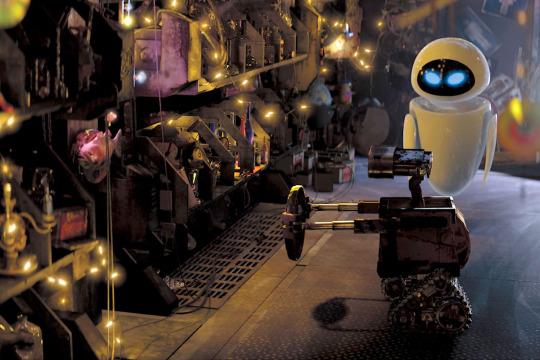
Things would need to be fully accessible for mobility aids, and steps would be shorter and closer together
Farming would be done on raised beds
Far more goods and products would be sized down to Little proportions - including clothes, tools, furniture, houses, etc.
Checkout counters would be lower
Automobiles would run tests on Little dummies, and change airbag patterns to prevent whip-lash
Public spaces would have low sinks, toilets, and changing tables
Hospital beds and furniture would be low enough for little people to use without assistance, and more research would be put towards properly dosing Little patients
And gosh, so much more..
-Elliot (they/them)
74 notes
·
View notes
Text
Gender refers to the legal institutes, societal roles, and expectations enforced on the sexes to automate exploitability. Reforming gender in its entirety while preserving any contemporary cultures as they currently exist is not possible.
Abolishing these roles and expectations, however, is.
Reforming the legal institutes imposed on the sexes to instead promote universal design, however, is.
26 notes
·
View notes
Text
7 notes
·
View notes
Text
Update on our GoFundMe page out NOW!!!⬇️⬇️⬇️
Thank you all SO much!!!
First and foremost, we want to thank everyone who has donated to the GoFundMe, and connected us with those who have helped make a true difference for Addie. This outpouring of generosity has been so beautiful to witness. Thank you. Here are a few exciting updates!
Thank you SO much to Marlin and Lisa at Plain Values Magazine for publishing the GoFundMe in their August issue! We are so incredibly grateful to have been featured, and for the opportunity to reach such a wide audience.
Thanks to the generosity of E-Sight, Addie will be sent the first new pair of glasses that comes out in the fall, and she currently has an excellent (and wireless!) pair she is using now.
Through the GoFundMe, we’ve been given access to some items that have been massively helpful while we search for long term medical purchases. Thank you to the folks who have been helping us get a foot (or rather a wheel) in the door with medical suppliers!
So far, we’ve managed to raise $24,480 thanks to the generosity of donations and the sharing of Addie’s story. Now we find ourselves filled with a much-needed hope for the hurtles ahead as we continue our fight by the Graf family’s side.
And finally, we have the next step. We have been given the opportunity to purchase an accessible van for Addie and Tricia. The dealership has been deeply empathetic and flexible to our needs. Thanks to that, they have generously agreed to give us a major discount.
However, we only have 21 days to keep the van & deal on hold, and reach our needed new goal of $65,000.
Thankfully, we are already a quarter of the way there! If we can come together and raise 40,000 more by the end of the month, we will be able to buy that van, and help Adeline explore the world more than she has been able to in years.
We hope you will continue with us on our journey by continuing to donate, share, and reach out for any help you may find.
Thank you again for everything!
#gofundme#gofundme friends of addie#go fund me#go fund me friends of addie#life changing medical needs for addie#reshare#donate#like#community#charity#disability#fundraiser#elizabeth taylor#tennessee#indiana#21 days#end of august#car#handicap accessible#universal design#deal#dealership#wheelchair#spoonie#together we can#chronic illness#advocacy#eds#mcas#cci
6 notes
·
View notes
Text
Today on "Why Diversity Matters": Floorplans
I'm hyperfixated on floor plans: it's a combination of daydreaming about homes and playing Tetris. I look on Pinterest, play around on Floorplanner, and joined the /r/floorplan subreddit, which is where I realized U.S. people live in another world.
Someone posted a plan for a two-bed/one-bath rectangular home they want to build with a footprint of 730 sq ft (68 m2 in non-freedom units). Some of the feedback made sense, but some of it was baffling, like:
Just put a bar, a dining table with chairs won't fit.
2 bedrooms are too many for the area. Be realistic.
A second bedroom is too small because it only fits a single bed and not a queen (OP said he needed it for an office that could double as a guest room).
If you have to put the bed in the corner against a wall it's too small because contact with your body will stain the walls (which isn´t wrong, it's just...)
These are the plans for a 68m2/730 sq ft apartment in my country:
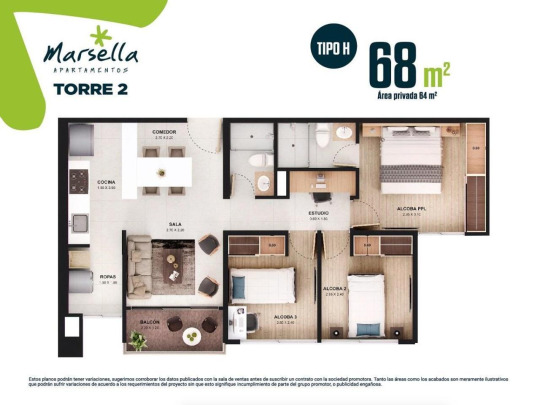
These are real apartments for sale, to scale, where actual families live. They have three bedrooms, two bathrooms, living, dining table, kitchen, utility area, office desk, and even a goddamn balcony! A family of 4 can live here somewhat tight, but with dignity. Now, this isn't rectangular like OP's plan, it's an apartment and not a house, I agree that this isn't ideal, and U.S. building codes are different. I would want more space too, but you can tweak this to fit what OP wanted:
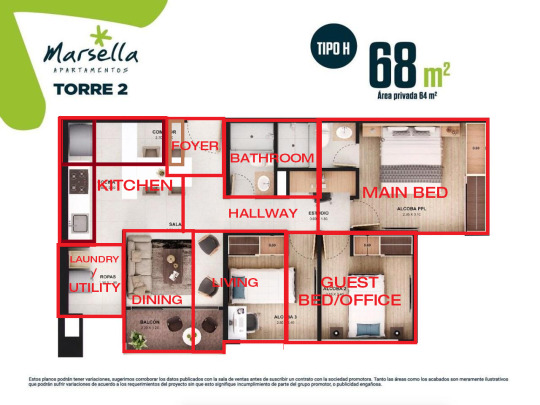
Look! A floorplan with decently U.S. dimensions! Even a foyer with a coat rack! Dining/living/kitchen would be an open or semi-open concept, I just divided it to show it all fits. A U.S. couple or even a family of three could live here in comfort (I'm sure an actual architect or drafter could fit a studio desk space to work as a home office just in case). I'm not an architect, I'm not even good at this. But I have been inside places like this, so I can imagine them.
What if architects and hobbyists (and general public?) from the U.S. and other places where big spaces are the norm took a look at how others make things work every once in a while? Especially in the developing world, where we can't afford expensive, customized hi-tech solutions to our space limitations? Your homes would still be big (which is great), but maybe they would be fewer McMansions full of wasted space, less distressing solutions to housing crises in big cities, or a middle ground between the big house/tiny house dichotomy.
Now it's easier than ever to see how people make things work all around the world, how we live in small spaces, big spaces, awkward ones, and our different approaches and materials. Maybe we should all start taking the best from each other.
P.S.: In countries where homes are bigger: Why isn't accessibility / universal design the standard? If you have at least 430 sq ft/40m2 of floor space per person and that's not a given, it's basically a waste of space.
7 notes
·
View notes
Text
DC Metro Family Room

An illustration of a mid-sized transitional enclosed family room design with blue walls and a medium tone wood floor
2 notes
·
View notes
Text
Keeping Covid-safe at school
I might have started my new academic admin job in August with the second-worst sinus infection of my life from a gd COLD (thanks, immune dysregulation!), BUT all the students are home now, which means I've successfully made it through my first semester ever without getting sick!
At the risk of jinxing myself before the holidays, I'm going to share with you what's worked for me, so you too can enjoy your holidays with minimal risk of infection.
1. This little buddy lives in my office:
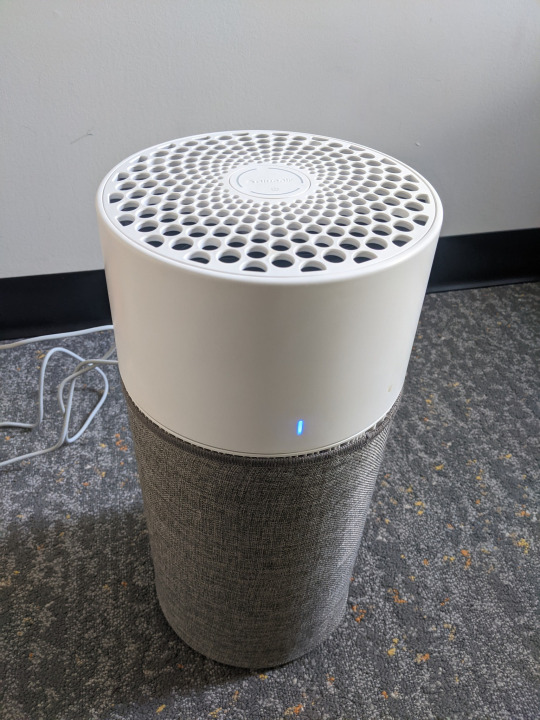
He's a Blue 411 HEPA air purifier that I got on sale at Target for $80. Every 13 minutes it cleans the air in the whole (tiny) space. My school has pretty decent air quality to begin with, but this guy gives me an extra boost — especially because I see students in my office. (Bonus: he's unbelievably quiet!)
2. I wear one of these EVERYWHERE:
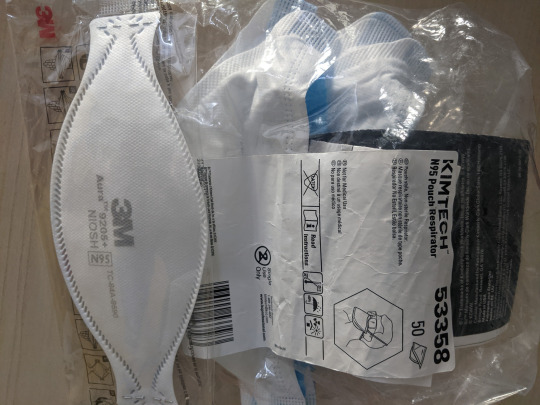
The only time they come off is outdoors; or in my office and I've been alone for 13+ minutes.
I wear 3M AURA N95 respirators in high-contact settings and during periods of high transmission on campus. They're the gold-standard and have an amazing seal for maximal protection and minimal glasses fogging!
In low-contact settings and when my facial eczema flares, I wear Kimtech duckbill N95 respirators. They're softer and more comfortable than the 3M AURAs, but the seal isn't the best.
3. I require students to wear some level of protection, which I have available in a bag taped to my door. Thankfully, school policy allows faculty and staff to set expectations for the spaces they control.
4. I could probably self-test more, but home tests are increasingly less accurate as the virus gets stealthier. When I do self-test, I swab my throat. They do this in Canada and it's a lot more effective than nasal only!
I've had a LOT of close calls this semester; students have, bizarrely, come in sick, even with my remote options. But, between aggressive air sanitation, high-level self-protection, and sheer luck, I've stayed well and I hope you can too!
Not getting sick 3x year has been life-changing and I don't ever plan to go back. As one friend pointed out, self-care is community care. The state doesn't keep us safe — we keep us safe!
9 notes
·
View notes
Text
Universal Design is Design Leadership
"An environment (or any building, product, or service in that environment) should be designed to meet the needs of all people who wish to use it. This is not a special requirement, for the benefit of only a minority of the population. It is a fundamental condition of good design. "
Principle 1: Equitable Use
Principle 2: Flexibility in Use
Principle 3: Simple and Intuitive Use
Principle 4: Perceptible Information
Principle 5: Tolerance for Error
Principle 6: Low Physical Effort
Principle 7: Size and Space for Approach and Use
Whereas traditional accessibility design creates design parameters based on the needs of a minority group/solely those with disabilities, the Universal Design #schema expands the #desideratum to include, well, everyone.
Ron Mace, the one who coined the term Universal Design, is a #design leader.
6 notes
·
View notes
Text
Ergo-Frugal Design
Meet our ideas so as to grow frugally for synthesizing concepts to plant an ergonomic intervention in designing human latent needs. Frugal design is about unwrapping the thought process for designing with constraints to optimize the use of resources, technology, and time. To identify new technologies and work collaboratively on needs and issues not addressed by the mainstream. Ergonomic intervention in design will make us think for common people whose latent needs are often overlooked and unseen.
#frugaldesign#ergonomicfrugal#microfrugal#designthinking#handsontraining#innovative#product design#universal design#intervention
8 notes
·
View notes
Text
iPhoneにBIZ UDフォントをインストール
はじめてiPhoneにフォントをインストールした。選んだのは、BIZ UDPゴシック。目的はシンプル。Day Oneライフを、より満喫するためだ。
Continue reading Untitled

View On WordPress
1 note
·
View note
Text
Disabled pride vs. awareness
On July 26th, 1990, George H. W. Bush signed the Americans with Disabilities Act. The ADA is a law that gives people with disabilities protection against discrimination in the workplace, public transportation, restaurants, schools, and much more. In addition, the law mandates accommodations that provide access and independence to people with disabilities to live their lives. That’s why July is disability pride month. It is a celebration of the diversity within the disabled community. The law prevents discrimination against all types of disability; mental illness, cognitive, intellectual, sensory, and physical. Each type is represented in the disability pride flag.
Why is it pride month and not awareness month? Awareness is acknowledging a diagnosis, and pride is a celebration. You might donate money to foundations during awareness months, but in pride months, you march and find community. July is a month to recognize all the feelings of people with disabilities. You don’t have to be proud of your disability to be included. July raises up voices of disabled people to tell their stories.
For me, people have always been “aware” of my disability. Because they can see my mobility aids. The questions like “What happened?” or “what’s wrong with your legs?” gets old quickly. Those situations made me resent my mobility aids for “outing” me as disabled. I learned over time that not using them made me slower and maybe look more “special” because of how I naturally walk. In the end, mobility aids provide more independence than unwanted questions.
My workaround for hiding my orthotics was to never under any circumstance wear shorts to school as a child.
That and to pick skin tone colors to make them blend in. (Although this usually made people think I had prosthetics versus leg braces, and having to explain that is awkward). In most pictures, I color-coded my crutches to my outfit. This was to minimize my mobility aids and disability as much as possible. My internal ableism grew out of assumptions others had about my disability. Awareness diminished the amount of pride I had.
#actually disabled#disabledcreator#disabled life#physical disability#disability culture#disabled pride#disabled community#ableism#mobility aid#awareness#pride#ada#accessability#universal design#anniversary#disabledrights#storytime#internal struggle#internalableism#july26th
8 notes
·
View notes
Text
Positive sex-segregation (women-only scholarships, women-only shelters, such and so forth) cannot coexist with pure gender abolition. Positive sex-segregation is another form of gender reformism, similar in form to that encouraged by queer theorists and their investors - though with the opposite intent: to prioritize ending misogyny rather than regrounding and reinforcing it.
Universal design (UD), inherently feminist when including females in "universal" (not currently implied, let alone actionably reflected by, UD literature) requires limited positive sex-segregated implementations.
All sex-segregation is implementation of gender. Female-inclusive UD, thus limited positive sex-segregated implementation of gender, is necessary for sex equality. In the present, anti-misogynistic functions must accommodate sexed average anatomical and physiological differences as well as the existence of established, present misogyny. In a theoretical future without misogyny, gender will still require implementation to accommodate sexed average anatomical and physiological differences, as otherwise, sexism is inevitable.
Gender should not be implemented in any capacity beyond curating environmental sex equality and ensuring lack of sexed discrimination.
Gender abolition should not be followed to antifeminist extremes, prioritizing one uniform idea of the human body over functions and systems which compliment the differences of sexed forms, even after social gender and sociolegal misogyny are successfully overwritten.
Currently, the male form is perceived as superior. The financially conservative approach of business is to accommodate the body of the average man. Under pure gender abolition, the financially conservative approach would be to accommodate the body of the average human, which would disadvantage both sexes. No further currency would be expended in production upfront, but lessened effectiveness and efficiency throughout the supply chain would cost much.
Female-inclusive universal design with positive sex-segregation is more costly upfront than the current model and the pure gender abolitionist model alike. It should conserve currency intensely not upfront, but further through supply chains.
Rather than accepting any design model encouraging the internal locus of control of financially conservative businesses - the misogynist current approach or the pure gender abolitionist approach, we must reject these entirely. Female-inclusive universal design with positive sex-segregation must be implemented to end misogyny. It's even cost-effective.
To end economic misogyny and female unpaid labor, fiscal conservatism must also be rejected.
Positive sex-segregation is gender and that is okay.
#universal design#gender abolition#gender reform#radical feminist community#economics#invisible women#caroline ciado-perez#mine
5 notes
·
View notes
Text
Universal Design: Pioneering Inclusivity and Sustainability in the Modern World
Banner Created with DALL-E
As I reflect upon my journey advocating for workplace diversity and inclusivity, one principle consistently emerges as a cornerstone: Universal Design (UD).
This concept, far from being a mere architectural notion, has been the guiding force in my pursuit of creating spaces and systems that embrace every individual’s unique needs and contributions. In our rapidly…

View On WordPress
1 note
·
View note
Text
Here is an interesting article…
https://www.businessinsider.com/cheap-starter-homes-manufactured-modular-housing-failing-real-estate-construction-2024-1?amp
What do you think?

View On WordPress
0 notes
Text
The Benefits of Universal Design
Universal design aims to make products, environments, and services accessible and usable by as many people as possible, regardless of age, ability, or situation.
Universal design aims to make products, environments, and services accessible and usable by as many people as possible, regardless of age, ability, or situation. It is based on the principles of flexibility, simplicity, and low physical effort and is often referred to as inclusive design or design for all.
There are numerous benefits to adopting universal design, both for individuals and society…

View On WordPress
0 notes